1.9: Terrines, Galantines, Forcemeats, and Pâtes
- Page ID
- 23632
\( \newcommand{\vecs}[1]{\overset { \scriptstyle \rightharpoonup} {\mathbf{#1}} } \)
\( \newcommand{\vecd}[1]{\overset{-\!-\!\rightharpoonup}{\vphantom{a}\smash {#1}}} \)
\( \newcommand{\id}{\mathrm{id}}\) \( \newcommand{\Span}{\mathrm{span}}\)
( \newcommand{\kernel}{\mathrm{null}\,}\) \( \newcommand{\range}{\mathrm{range}\,}\)
\( \newcommand{\RealPart}{\mathrm{Re}}\) \( \newcommand{\ImaginaryPart}{\mathrm{Im}}\)
\( \newcommand{\Argument}{\mathrm{Arg}}\) \( \newcommand{\norm}[1]{\| #1 \|}\)
\( \newcommand{\inner}[2]{\langle #1, #2 \rangle}\)
\( \newcommand{\Span}{\mathrm{span}}\)
\( \newcommand{\id}{\mathrm{id}}\)
\( \newcommand{\Span}{\mathrm{span}}\)
\( \newcommand{\kernel}{\mathrm{null}\,}\)
\( \newcommand{\range}{\mathrm{range}\,}\)
\( \newcommand{\RealPart}{\mathrm{Re}}\)
\( \newcommand{\ImaginaryPart}{\mathrm{Im}}\)
\( \newcommand{\Argument}{\mathrm{Arg}}\)
\( \newcommand{\norm}[1]{\| #1 \|}\)
\( \newcommand{\inner}[2]{\langle #1, #2 \rangle}\)
\( \newcommand{\Span}{\mathrm{span}}\) \( \newcommand{\AA}{\unicode[.8,0]{x212B}}\)
\( \newcommand{\vectorA}[1]{\vec{#1}} % arrow\)
\( \newcommand{\vectorAt}[1]{\vec{\text{#1}}} % arrow\)
\( \newcommand{\vectorB}[1]{\overset { \scriptstyle \rightharpoonup} {\mathbf{#1}} } \)
\( \newcommand{\vectorC}[1]{\textbf{#1}} \)
\( \newcommand{\vectorD}[1]{\overrightarrow{#1}} \)
\( \newcommand{\vectorDt}[1]{\overrightarrow{\text{#1}}} \)
\( \newcommand{\vectE}[1]{\overset{-\!-\!\rightharpoonup}{\vphantom{a}\smash{\mathbf {#1}}}} \)
\( \newcommand{\vecs}[1]{\overset { \scriptstyle \rightharpoonup} {\mathbf{#1}} } \)
\( \newcommand{\vecd}[1]{\overset{-\!-\!\rightharpoonup}{\vphantom{a}\smash {#1}}} \)
\(\newcommand{\avec}{\mathbf a}\) \(\newcommand{\bvec}{\mathbf b}\) \(\newcommand{\cvec}{\mathbf c}\) \(\newcommand{\dvec}{\mathbf d}\) \(\newcommand{\dtil}{\widetilde{\mathbf d}}\) \(\newcommand{\evec}{\mathbf e}\) \(\newcommand{\fvec}{\mathbf f}\) \(\newcommand{\nvec}{\mathbf n}\) \(\newcommand{\pvec}{\mathbf p}\) \(\newcommand{\qvec}{\mathbf q}\) \(\newcommand{\svec}{\mathbf s}\) \(\newcommand{\tvec}{\mathbf t}\) \(\newcommand{\uvec}{\mathbf u}\) \(\newcommand{\vvec}{\mathbf v}\) \(\newcommand{\wvec}{\mathbf w}\) \(\newcommand{\xvec}{\mathbf x}\) \(\newcommand{\yvec}{\mathbf y}\) \(\newcommand{\zvec}{\mathbf z}\) \(\newcommand{\rvec}{\mathbf r}\) \(\newcommand{\mvec}{\mathbf m}\) \(\newcommand{\zerovec}{\mathbf 0}\) \(\newcommand{\onevec}{\mathbf 1}\) \(\newcommand{\real}{\mathbb R}\) \(\newcommand{\twovec}[2]{\left[\begin{array}{r}#1 \\ #2 \end{array}\right]}\) \(\newcommand{\ctwovec}[2]{\left[\begin{array}{c}#1 \\ #2 \end{array}\right]}\) \(\newcommand{\threevec}[3]{\left[\begin{array}{r}#1 \\ #2 \\ #3 \end{array}\right]}\) \(\newcommand{\cthreevec}[3]{\left[\begin{array}{c}#1 \\ #2 \\ #3 \end{array}\right]}\) \(\newcommand{\fourvec}[4]{\left[\begin{array}{r}#1 \\ #2 \\ #3 \\ #4 \end{array}\right]}\) \(\newcommand{\cfourvec}[4]{\left[\begin{array}{c}#1 \\ #2 \\ #3 \\ #4 \end{array}\right]}\) \(\newcommand{\fivevec}[5]{\left[\begin{array}{r}#1 \\ #2 \\ #3 \\ #4 \\ #5 \\ \end{array}\right]}\) \(\newcommand{\cfivevec}[5]{\left[\begin{array}{c}#1 \\ #2 \\ #3 \\ #4 \\ #5 \\ \end{array}\right]}\) \(\newcommand{\mattwo}[4]{\left[\begin{array}{rr}#1 \amp #2 \\ #3 \amp #4 \\ \end{array}\right]}\) \(\newcommand{\laspan}[1]{\text{Span}\{#1\}}\) \(\newcommand{\bcal}{\cal B}\) \(\newcommand{\ccal}{\cal C}\) \(\newcommand{\scal}{\cal S}\) \(\newcommand{\wcal}{\cal W}\) \(\newcommand{\ecal}{\cal E}\) \(\newcommand{\coords}[2]{\left\{#1\right\}_{#2}}\) \(\newcommand{\gray}[1]{\color{gray}{#1}}\) \(\newcommand{\lgray}[1]{\color{lightgray}{#1}}\) \(\newcommand{\rank}{\operatorname{rank}}\) \(\newcommand{\row}{\text{Row}}\) \(\newcommand{\col}{\text{Col}}\) \(\renewcommand{\row}{\text{Row}}\) \(\newcommand{\nul}{\text{Nul}}\) \(\newcommand{\var}{\text{Var}}\) \(\newcommand{\corr}{\text{corr}}\) \(\newcommand{\len}[1]{\left|#1\right|}\) \(\newcommand{\bbar}{\overline{\bvec}}\) \(\newcommand{\bhat}{\widehat{\bvec}}\) \(\newcommand{\bperp}{\bvec^\perp}\) \(\newcommand{\xhat}{\widehat{\xvec}}\) \(\newcommand{\vhat}{\widehat{\vvec}}\) \(\newcommand{\uhat}{\widehat{\uvec}}\) \(\newcommand{\what}{\widehat{\wvec}}\) \(\newcommand{\Sighat}{\widehat{\Sigma}}\) \(\newcommand{\lt}{<}\) \(\newcommand{\gt}{>}\) \(\newcommand{\amp}{&}\) \(\definecolor{fillinmathshade}{gray}{0.9}\)Introduction
All of Europe and especially France have made the most significant pioneering developments in the storied categories of terrines, pates, galantines, and forcemeats. They run the gamut from country style and rustic to haute, grand and luxurious. It can be argued that these forms are the heart and soul of the art in the cold kitchen. Though rarely seen in ordinary eateries, there has been an indisputable movement in recent years concentrating on skills and technique that have brought this and many other long forgotten masterpieces back into the repertoire of kitchens across the greatest food hotspots in the world. The techniques are being broadened as this movement grows as in the example of salad creations utilizing aspic to bind layers and add intrigue and elevating the simplistic to new heights. In this chapter, we will explore forcemeats, which are the basis for making most of the items discussed.
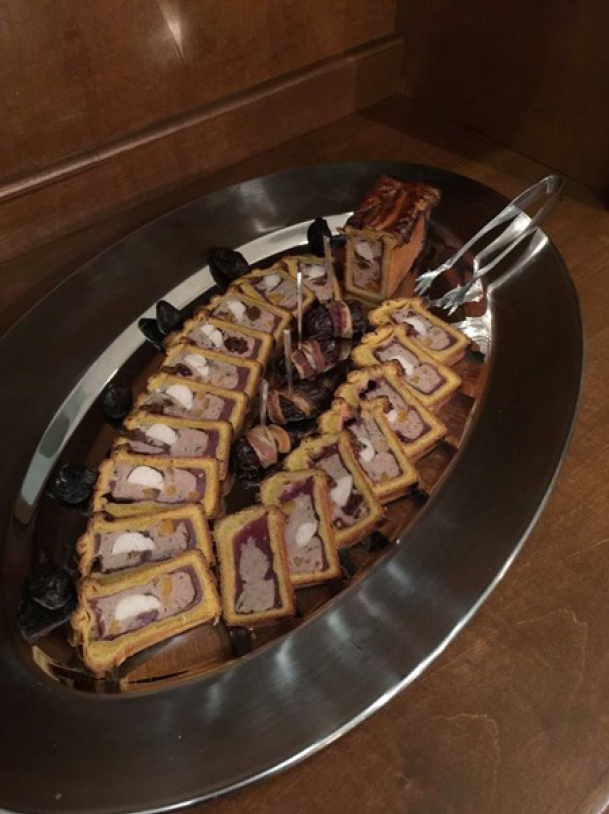
Chef Welsh’s Turkey and Cranberry Aspic En Croute, photo by Marshall Welsh CEC
Forcemeats
Think of forcemeats as the elemental ingredient in the preparation of most charcuterie creations of the Garde Manger. It is a lean meat emulsified with fat by grinding or processing in a food processor; often they are sieved and sometimes even pureed. The desired end result will dictate the procedures to use. Some products like a country pate may need to be rustic, therefore more toothsome and may simply require grinding while others may desire a smooth texture and benefit for processing, pureeing, and sieving. Using cold equipment and tasting prior to cooking are necessary to achieve a good product.
Forcemeats can be used for stuffing the centers of galantines, the making of sausages, quenelles to garnish platters, pates, terrines, roulades, and jabonnettes. Each forcemeat category has its own texture profile and we codify them into four categories.
Straight Forcemeats
These is made by combining pork meat and pork fat to another meat in equal parts. The meats and fat are cut into cubes, seasoned, cured, rested under chilled conditions, and processed via progressive grinding with cold equipment. Progressive grinding means to begin grinding with a coarse die and again with a smaller die.
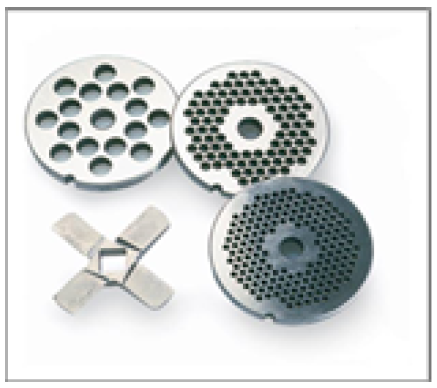
Formula for Straight Forcemeats: Pork and Fat + Dominant Meat + Seasonings/Cure
Pork and Fat plus an equal amount of the dominant meat is the ratio.
Another way to create a forcemeat is to grind the parts above with a medium die and further process in a mixer or a food processor. At times, the binding is enhanced at this point by the addition of raw egg to the forcemeat. If a smoother texture is desired, the addition of heavy cream will accomplish this and add a richness to the end product.
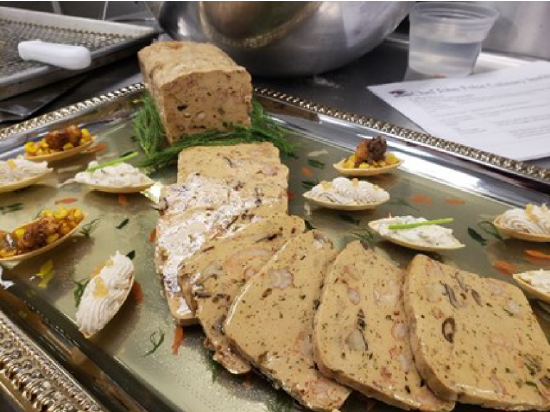
An example of a terrine with the straight forcemeat method from class
During this process, take care to use ice baths to keep the emulsion chilled and test for consistency. Always cook a small amount to check for taste so that you may adjust seasonings prior to completion. Use a cooking method that is close to the one in your recipe. For example, if your galantine is poached, roll a small portion of the forcemeat in plastic wrap and form a tiny sausage; tie the ends and poach it. The flavor will not be changed due to caramelization that you will encounter if you pan fry the tasting sample. These straight forcemeats can be used to fill a pate en croute, terrines, and galantines.
Refer to course handouts and or recipes provided by your instructor via the LMS (Learning Management System) ex. Moodle®.
Country Style Forcemeats
These are more rustic, coarse in texture, bolder in flavor, and usually made with pork, pork fat, liver, and other garnish ingredients. I have also seen a country style pate that was made primarily of mushrooms. One technique when making country style forcemeats is to make the first grind with the coarse die and reserve some of the mixture while grinding the rest again through the medium die.
The twice ground portion is then added to a panada (a binder made of a starch and a liquid) and mixed before combining the two grinds together. The panada helps to bind the two grinds throughout and after the cooking process. This method could work very well with Cajun Andouille as traditionally we use a coarse die to achieve large chunks of smoked pork meat in the sausage.
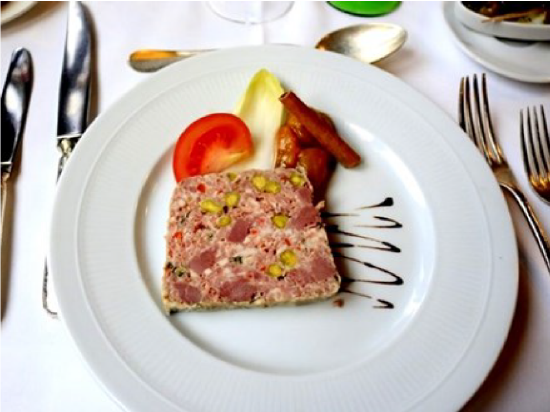
An example of a Country Style forcemeat pate (Rabbit and Pistachio)
commons.wikimedia.org
Gratin Forcemeats
These forcemeats are a close cousin to straight forcemeats, but require a light searing of the meat that adds color and depth of flavor to the product. To do this work in small batches and use a hot pan. Sear the meats (usually a liver) lightly without cooking all the way through. Keep the fond on the pan and reserve the meat on a pan on the side after each batch. Cool before processing.
Some recipes call for aromatics such as finely diced shallots or onion and a flambé with brandy after caramelizing in the fond left behind by the meats. Chill this with the meats and process as you would a straight forcemeat. Progressive grinding and processing with the use of a panada will bind the product.
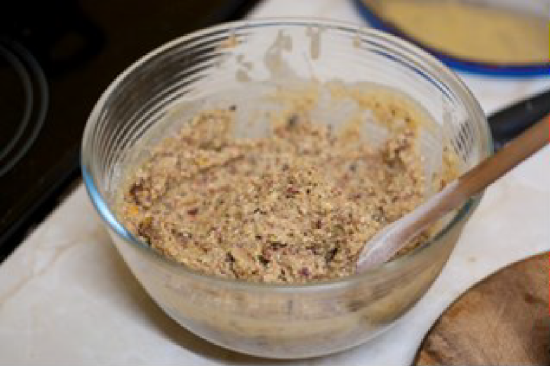
An example of the gratin consistency once processed- www. Flicker .com
Mousseline Forcemeats
These very lightly textured forcemeats used primarily with lean white fish, chicken, veal, and or shellfish. In most cases, the use of cream and eggs allows mousselines to have a light and airy texture. Below is a standard ration though you should always consult your recipe.
Lean white protein (1 lb.) + Salt (1 tsp.) + Egg or whites (1ea.) + Cream (8 oz.)
The procedure is to dice the protein and possibly grind if needed before processing. Process the meat and salt to a paste consistency. Note that certain shellfish as scallops may retain more water so be careful with the cream. Process with the egg white then follow with the cream. Scrape down the bowl during the process to reach a homogeneous blend for a consistent product. This process does not take long so do not over work the mousse. Very fine forcemeats maybe worked through a sieve or Tamis for the best consistency. This is especially true for rabbit as it has a sinew that should be worked out by the screen of the Tamis.
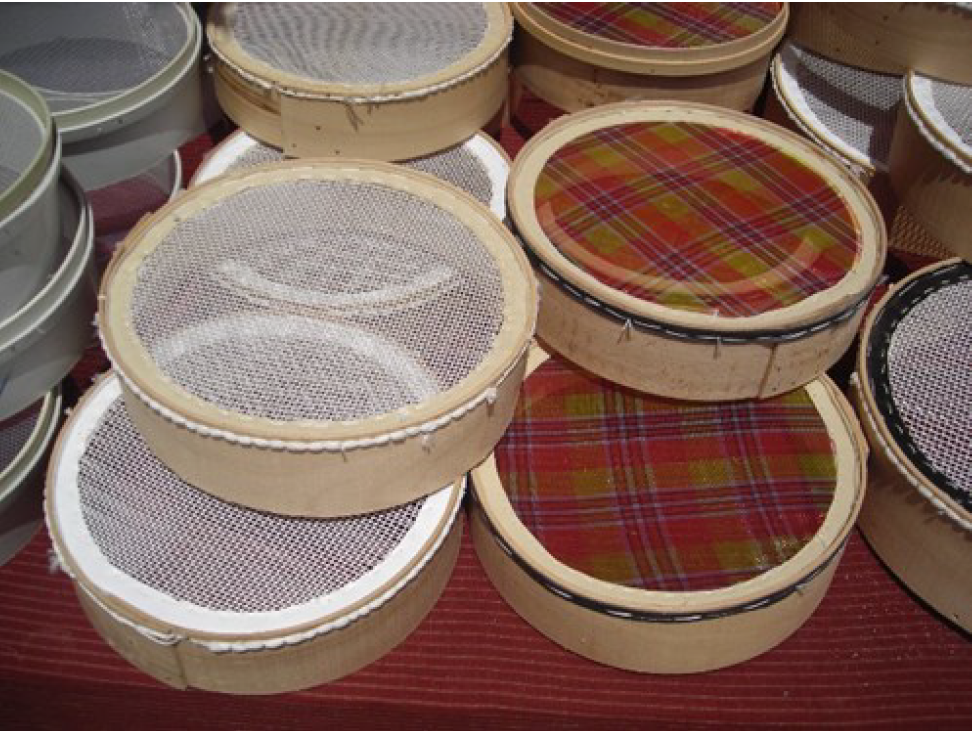
An example of various Sieves or Tamis- commons Wikimedia.org
Terrines
Terrines refer to pates that are made in an earthenware mold. They can be baked in a water bath (Bain Marie), or made in layered aspic as in the case of a cold vegetable terrine. Any style of forcemeat can be made into a terrine. Some can be enrobed in plastic wrap to help remove it from the mold while others are wrapped in bacon, ham, or vegetable for flavor and visual appeal. Still others are made in the style “En Croute” meaning to enrobe in a pastry crust while baking.
Terrines can be sliced from a loaf, or presented as an individual serving as in the case of rillettes. They normally are served as a course in a meal and can be a salad itself or accompanied by a salad.
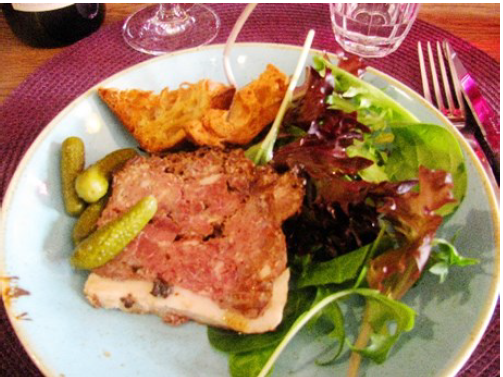
A liver pate course served with a salad- commons. Wikimedia.org
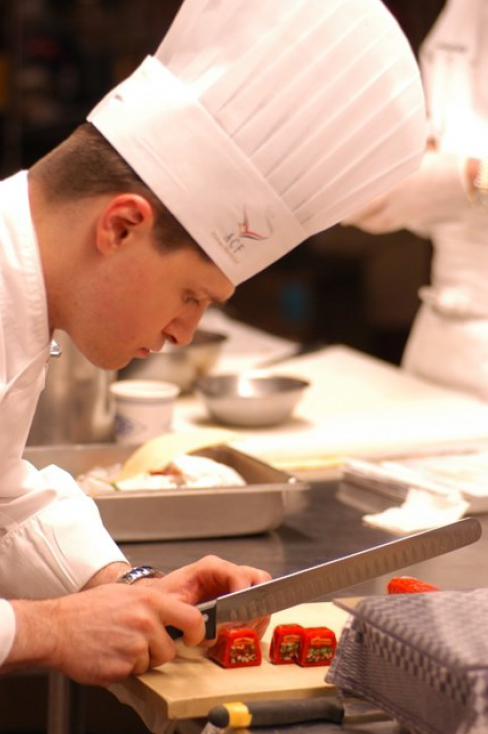
CMC Rosendale cutting a vegetable terrine bound in aspic-
commons.wikimedia.org
Basic steps for building a terrine include the following:
- Line the terrine mold. Traditional lining include thinly sliced fat back, bacon, ham, blanched and shocked green leeks, prosciutto, caul fat or even plastic wrap. When using plastic wrap gently mist the inside of the mold with water and lower the film inside using a towel or brush to press out the edges. Be certain to avoid air pockets between the mold and the lining.
- Fill the lined mold. With fine mousses, use a pastry bag. With country pates, you may wish to scoop some into your hand and throw it in to compress and avoid air gaps. A spatula in a good choice. After filling fold over the liner to encase the pate and tap the mold on the table to release any unwanted air. Cover with the lid before cooking.
- Cook the terrine in a Bain Marie. By placing the terrine in a water bath, we protect the product from heat extremes. Place a towel into a hotel pan. Place the filled and covered terrine mold on the towel and pour simmering water into the pan until it reaches most of the way up the side of the mold. Maintain the water temperature at 165°F. An oven temperature of 300°F should be fine.
- Cook the terrine until you reach the correct internal temperature. Here is the range below:
- Fish, shellfish, and pork- 145°F
- Beef, venison, lamb, and veal- 155°F
- Poultry- 165°F
- Cool, press and refrigerate the terrines. Remove the fully cooked terrine from the water bath and cool on the table until the pate falls to 90°F. Place a wrapped press plate on the product with a 2-pound weight. Place in the refrigerator for several days to allow flavor to mature. The terrine may then be coated in aspic if desired or sliced and dipped in aspic as in the classic cold platter form. (More about aspic in chapter ten.)
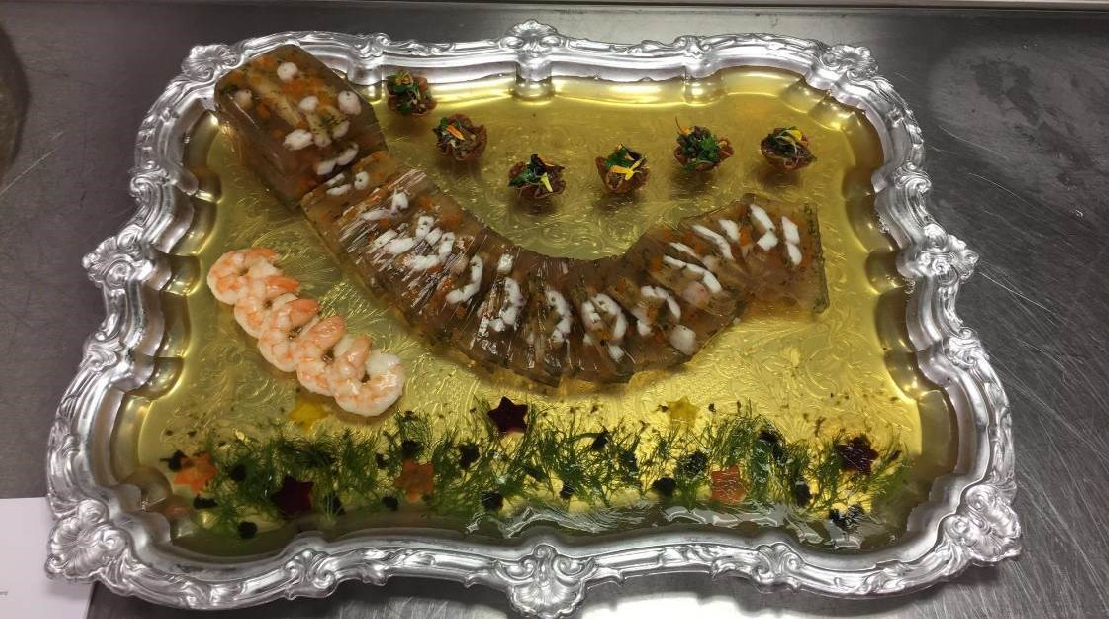
CJFCI student Taylor Mason’s Pulpo in Aspic Terrine
Aspic bound terrines
Important things to remember when using this technique is first to season the main ingredients as they are the starring cast members. Select a richly flavored stock to use as the aspic. Take care in their preparations; avoid cloudiness, and use only the amount necessary between layers. Speaking of layers, use an ice bath for the terrine mold and thoroughly chill each layer’s aspic before the addition of subsequent layers to avoid the sliding of unbound layers. Think of the aspic as the mortar between layers of masonry.
Galantines
In most every case, a galantine is made with chicken and refers to chicken white meat stuffed with a dark meat (and often pork and fat) forcemeat rolled into a tube shape and enrobed in the skin of the very chicken just fabricated for the technique. The galantine is wrapped again in plastic or cheesecloth, poached to 165°F, chilled, sliced and coated with aspic, then served on a decorative chemise coated platter.
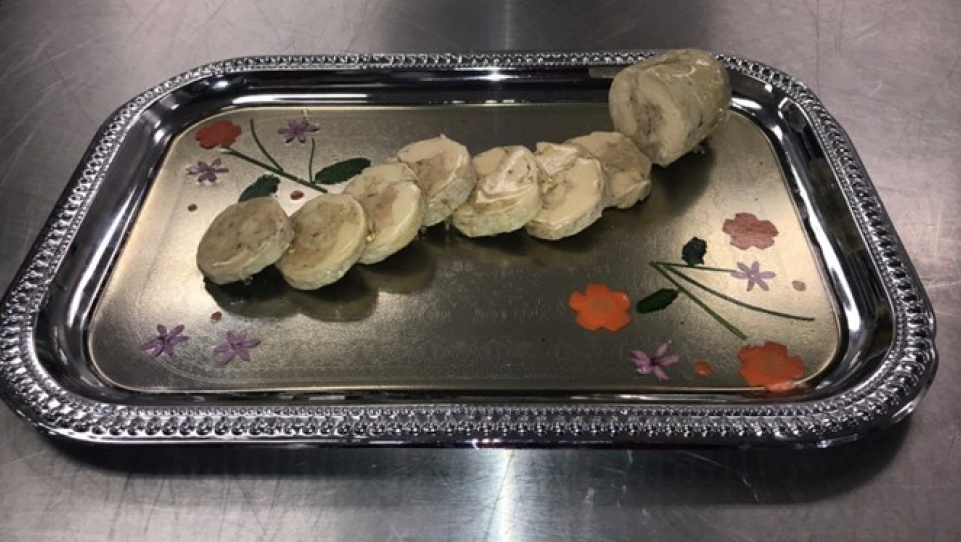
An example of a Chicken Galantine prepared by a student at CJFCI
Setting up for Galantine Production
- Begin with good organization Mise En Place
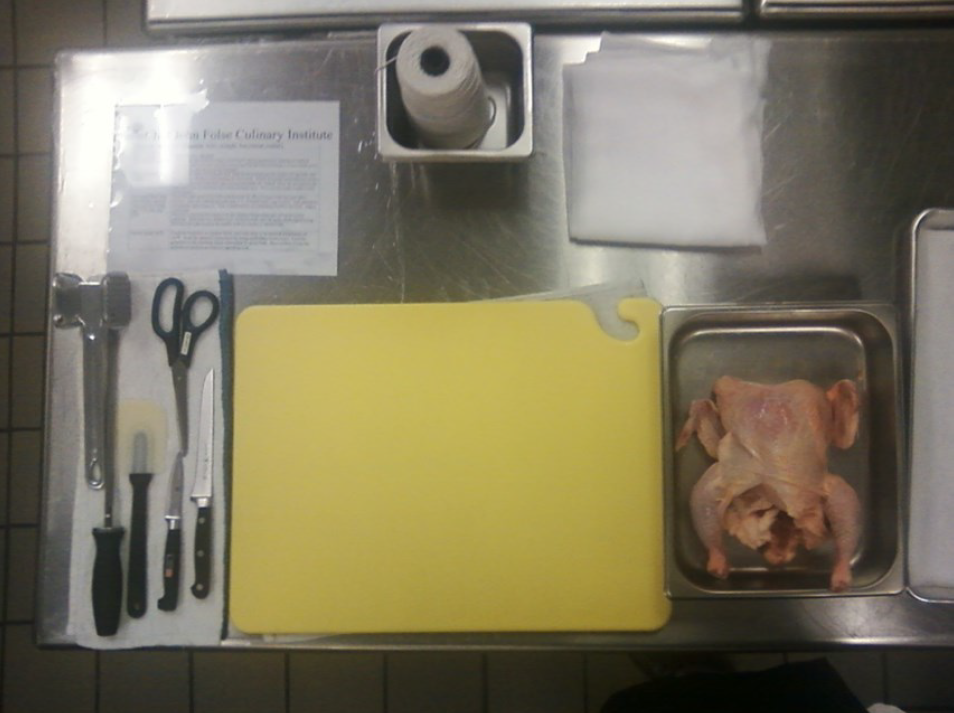
- Remove the skin from the bird, starting with an incision along the back.
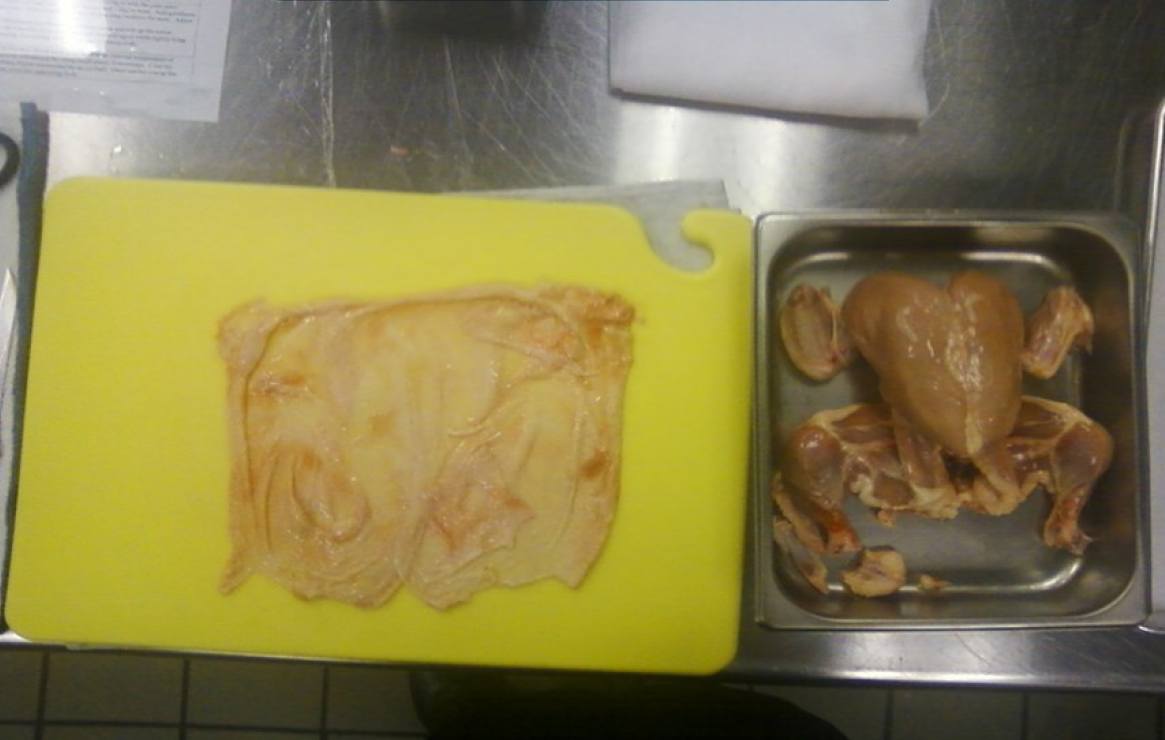
- Square up the skin with the inside facing upward
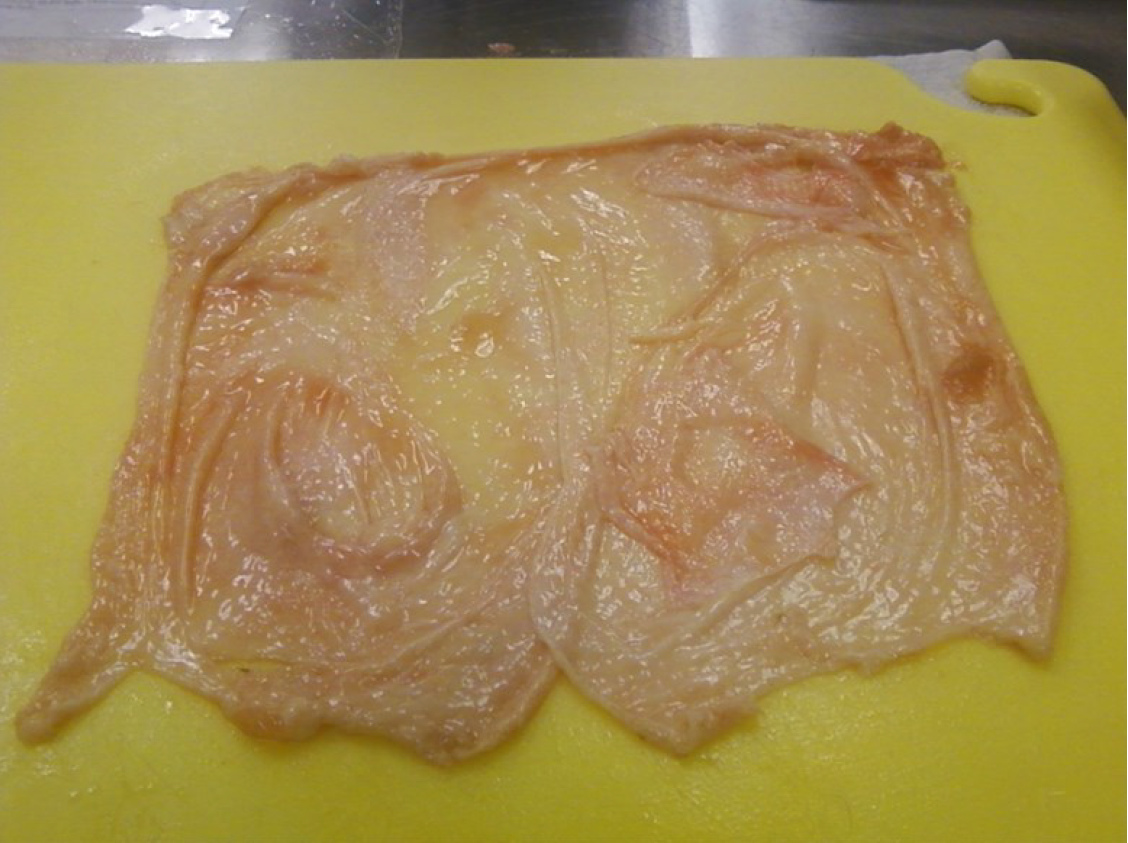
- Bone out the bird. Remove the tenders, breast and debone the legs.
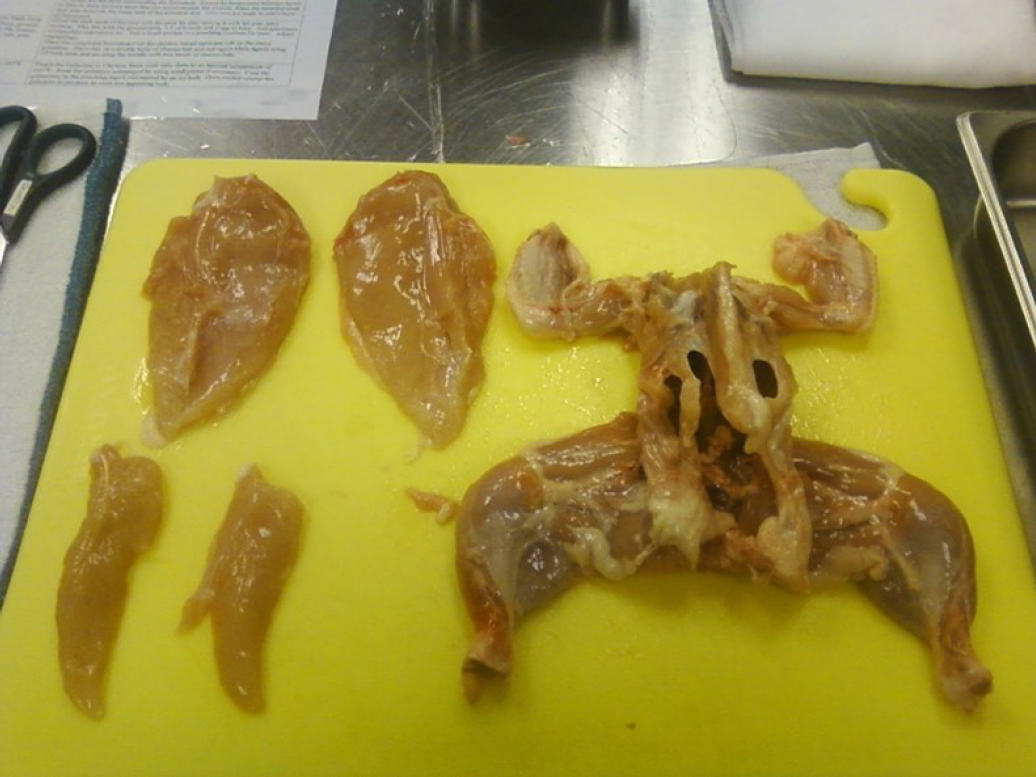
- Reserve the bones for stock and remove tendons from tenders.
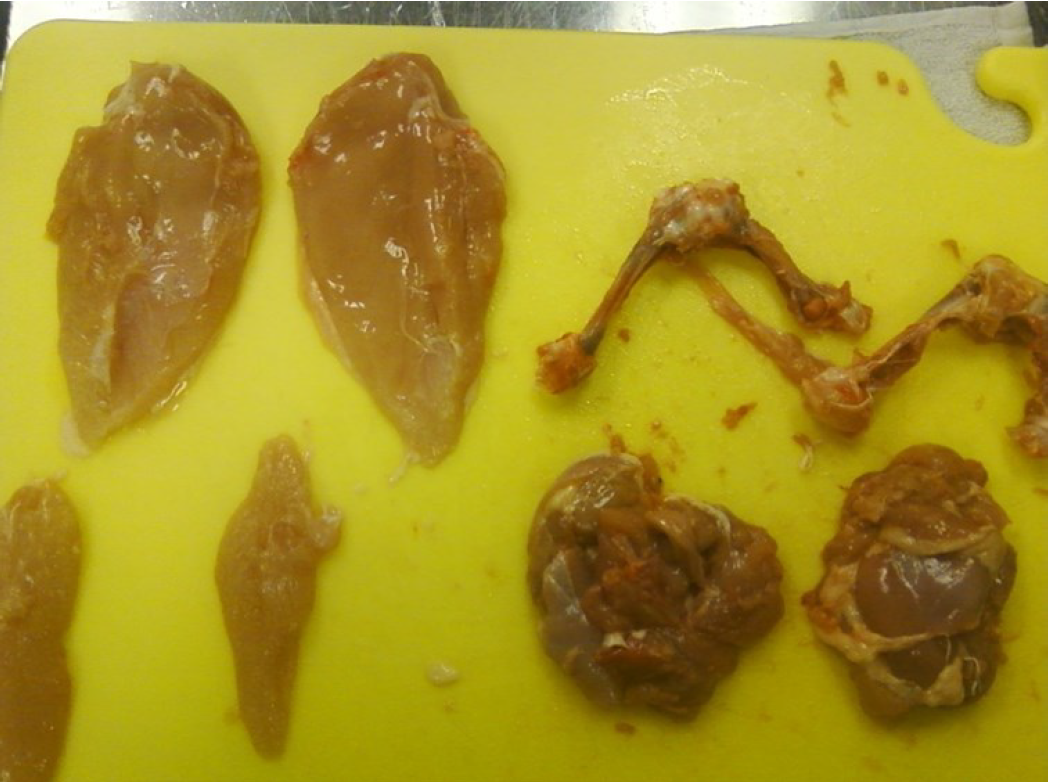
- Pound the tenders to and even thickness of ¼”.
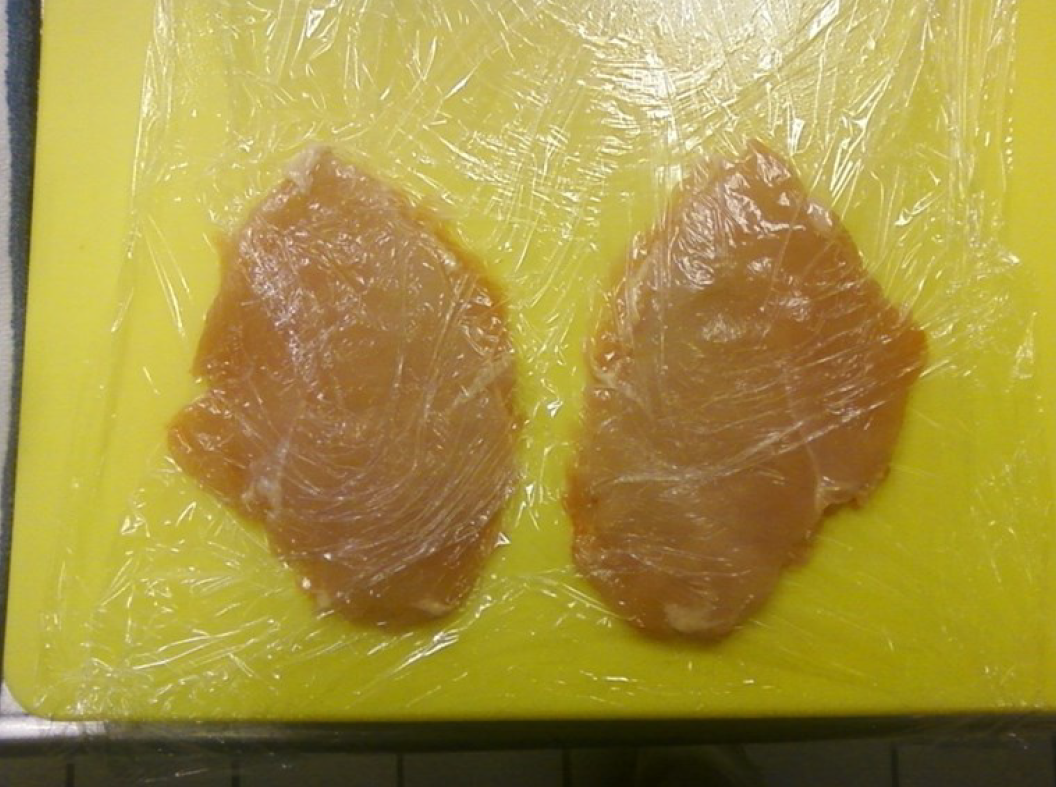
- Arrange the breast, but along the long side. Rotate ¼ turn left from shown.
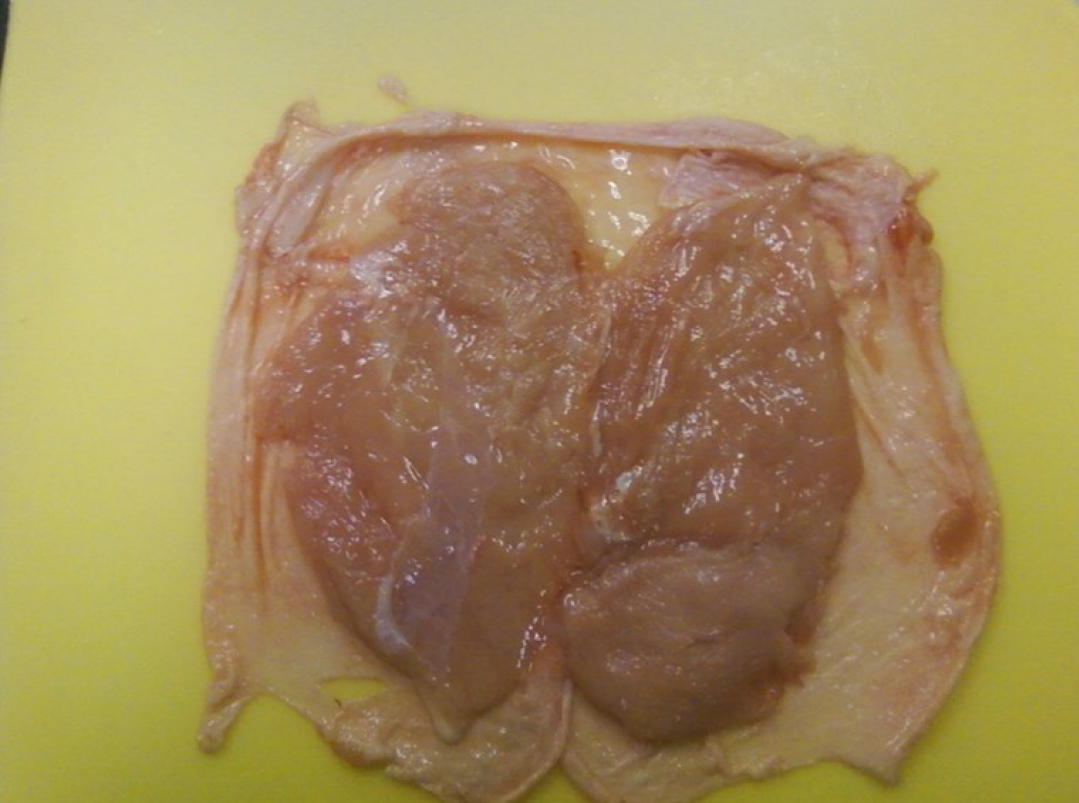
- Combine ground chicken with spices and pork. Mix and chill.
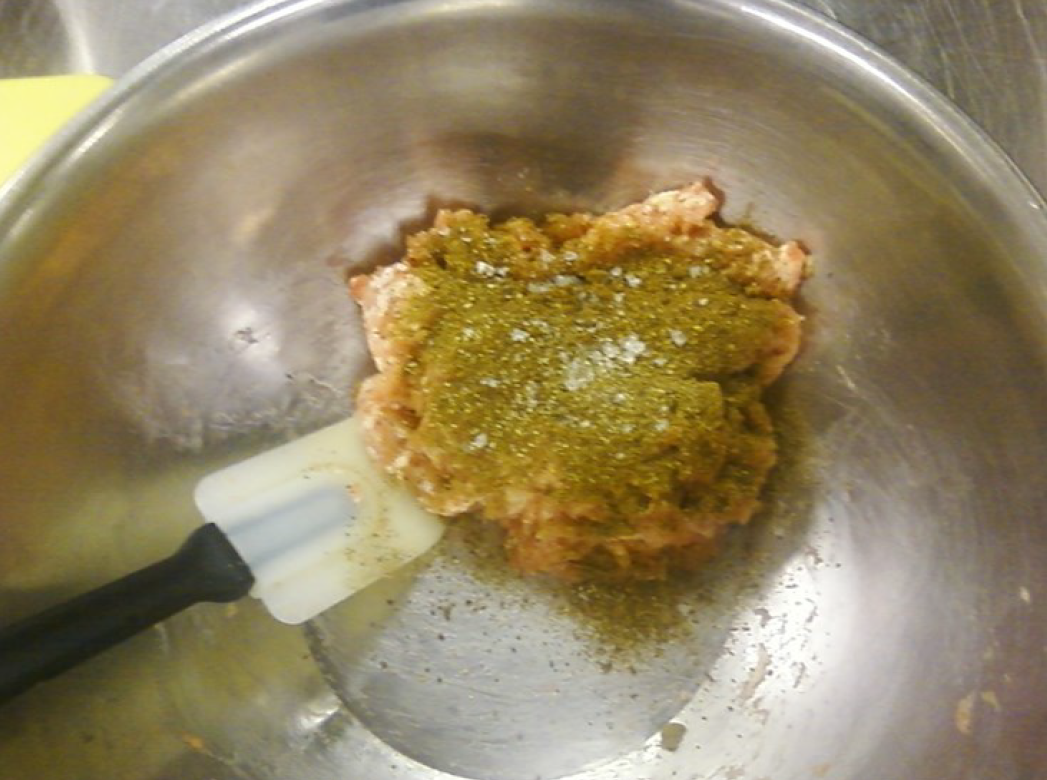
- Make an emulsion of the forcemeat with some ice in the processor.
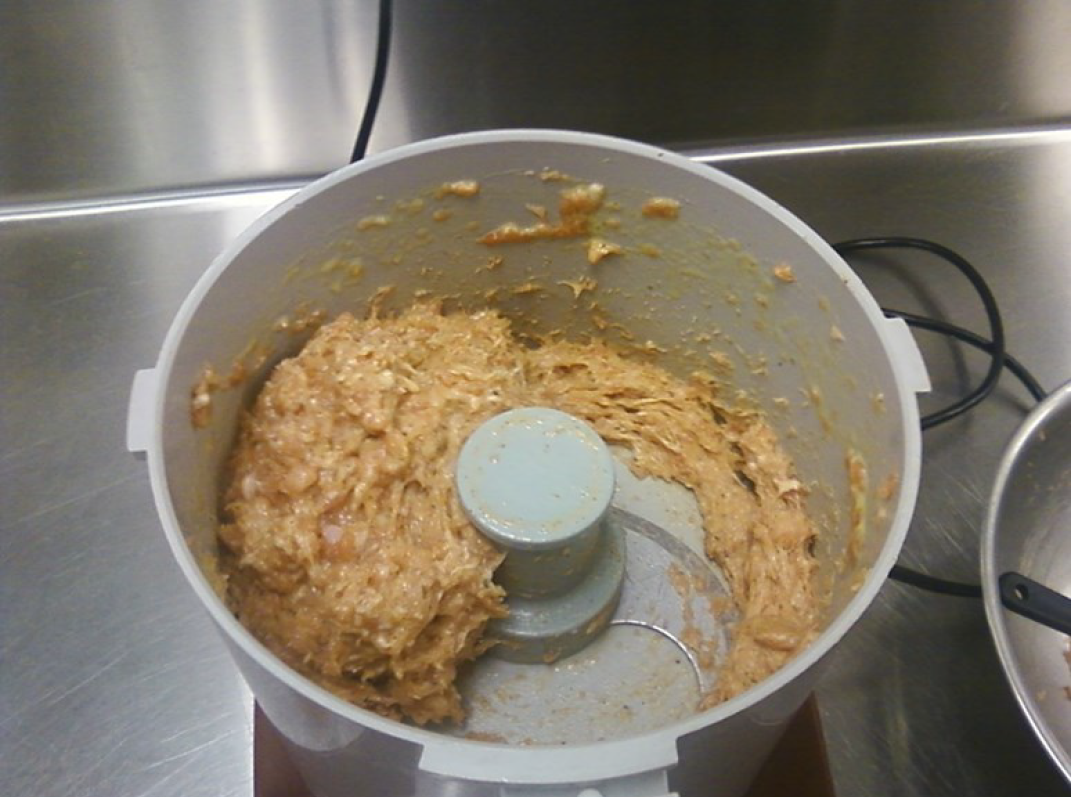
- Place some of the forcemeat over the breast; add tenders for garnish then more forcemeat.
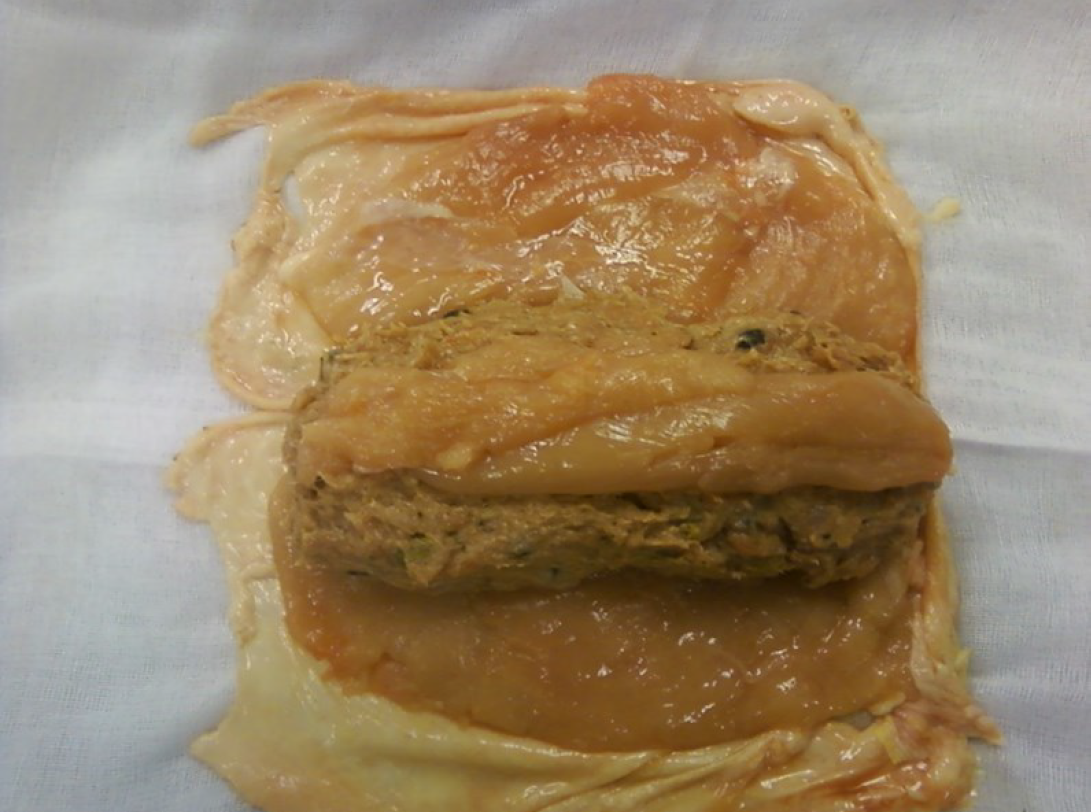
- Another layer of forcemeat over the garniture.
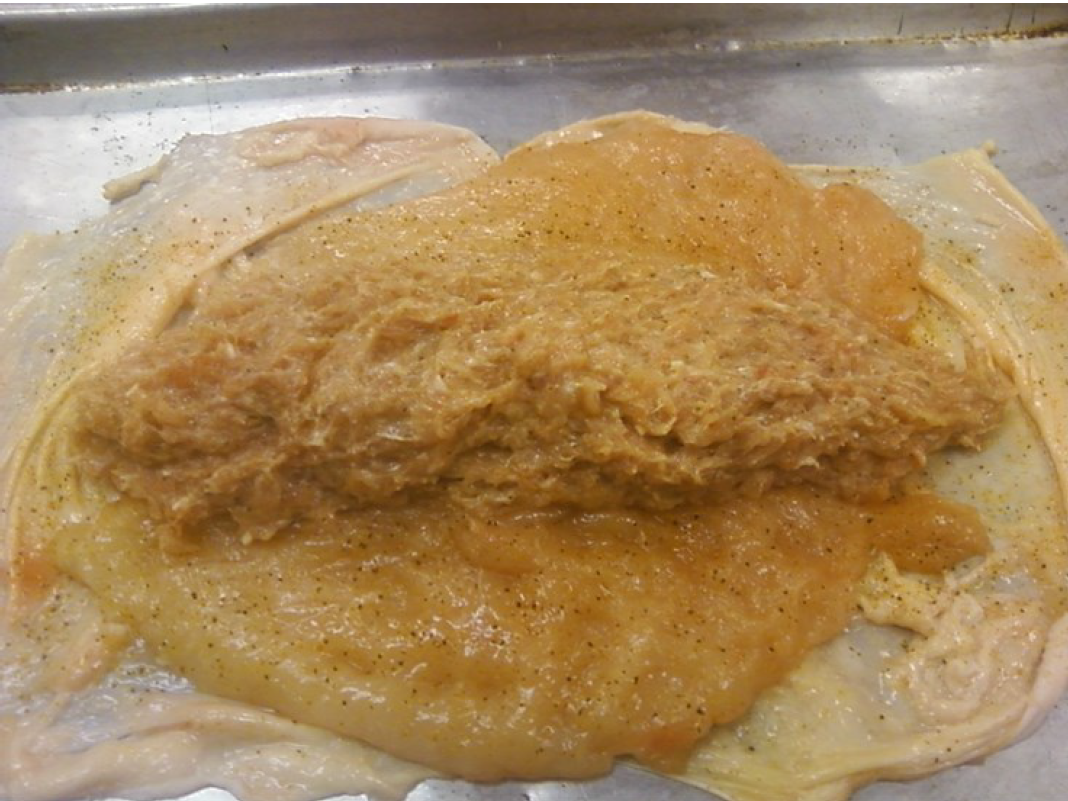
- Wrap and transfer the galantine to plastic wrap.
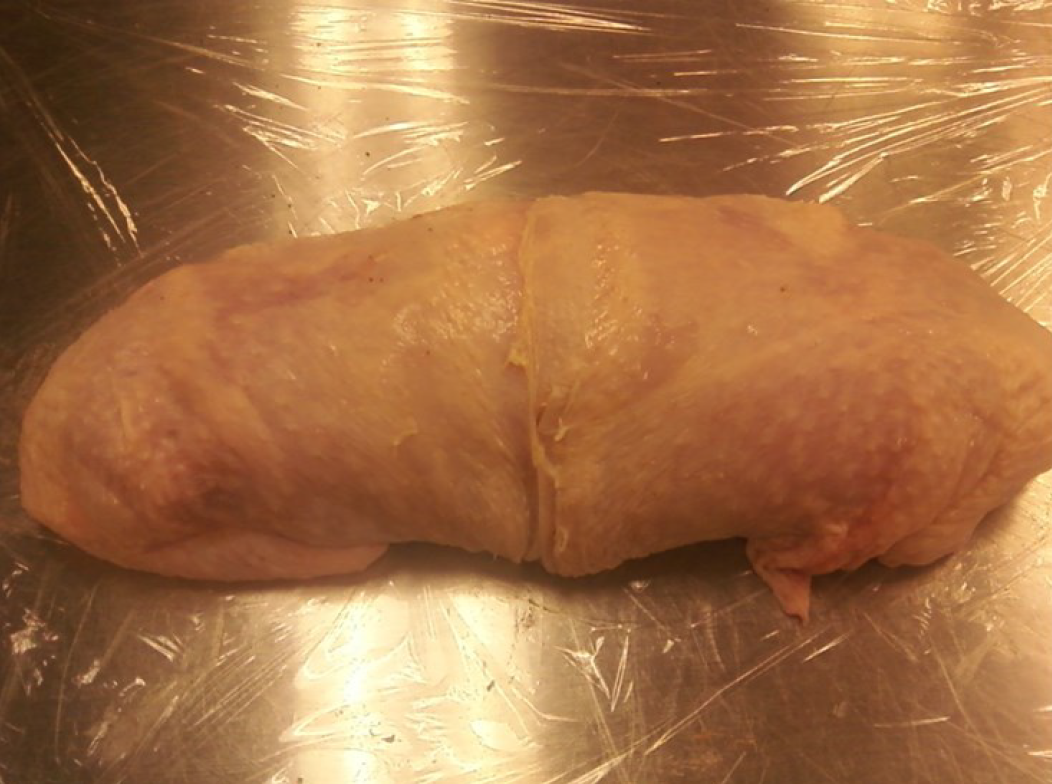
- Roll up the galantine. Press out the air and roll and twist ends. Tie the ends and poach to 165⁰F.
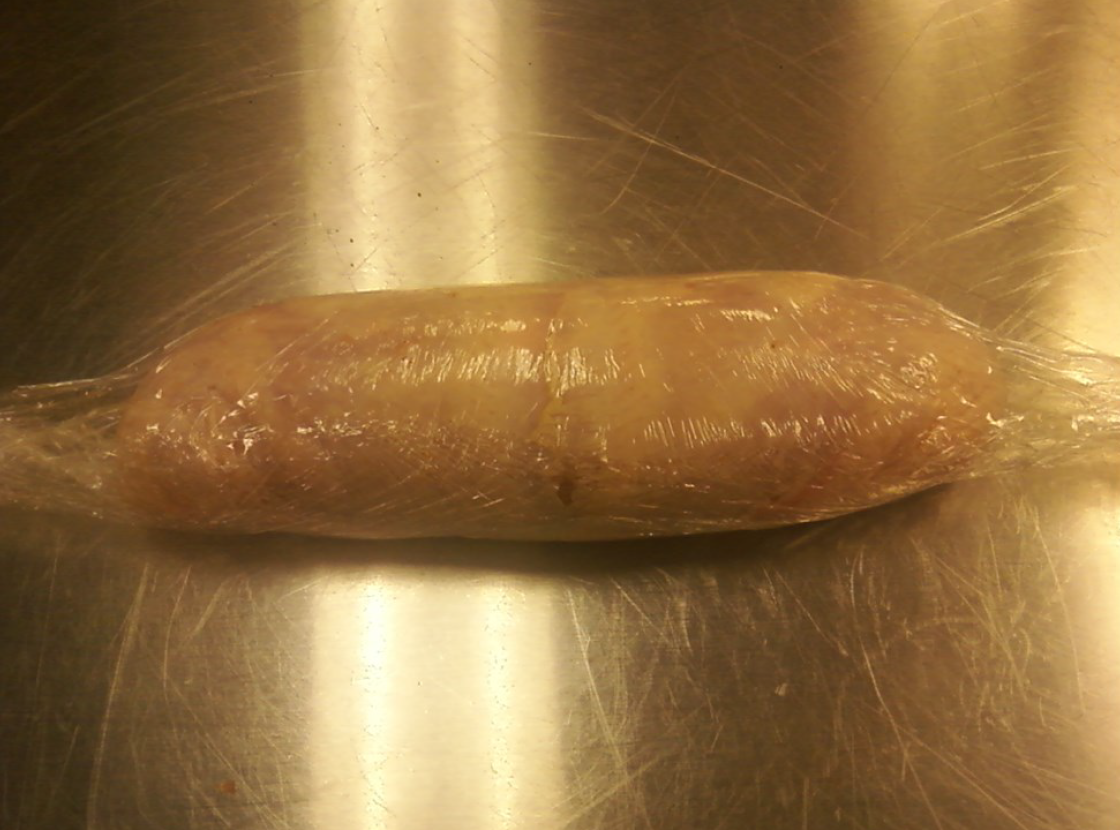
Pictorial by Marshall Welsh CEC
- List the four categories of forcemeats
- T or F. Circle one. Straight forcemeats combine pork and fat with a dominant meat in equal parts.
- T or F. Circle one. Country style forcemeats are coarse in texture, bold in flavor, and usually have pork and liver in its ingredients.
- What is a primary difference in gratin forcemeat that is not done with any other forcemeat?
- What two ingredients allow mousselines to have a light and airy texture?
- What is the technical term for the water bath used when baking a terrine?
- Name three things that we can use as the liner in a terrine mold.
- What should the internal temperature be for the following types of terrines?
- Fish _______________. Beef ________________ Poultry________________.
- What should you do when the temperature is reached in the terrine process?
- Use of an _______ __________ helps to set the aspic layers in the aspic terrine process


